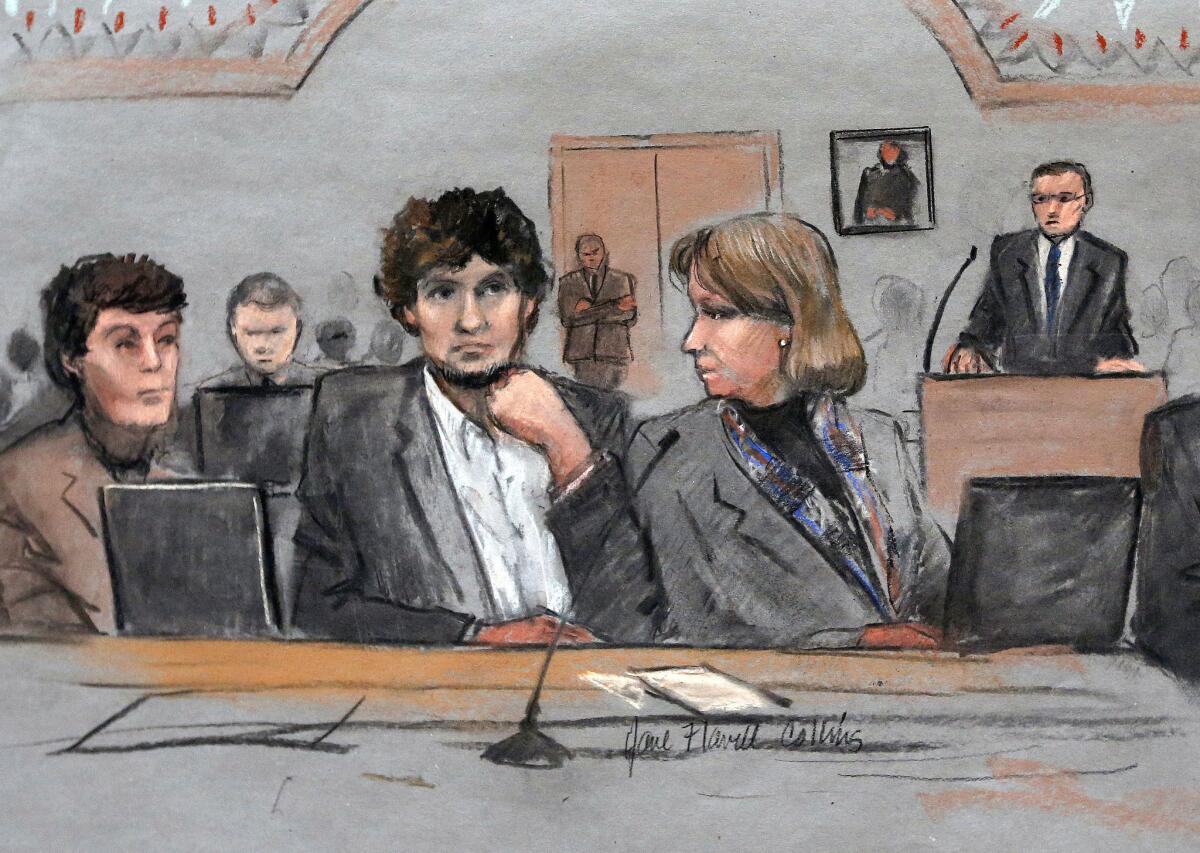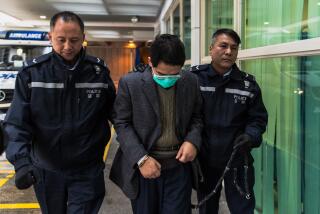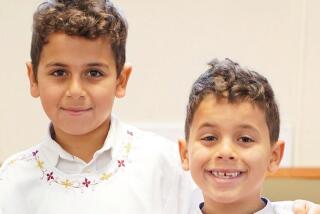Prosecution says Boston Marathon bomber is as guilty as his dead brother

A March 5 sketch shows Dzhokhar Tsarnaev, center, between defense attorneys Miriam Conrad, left, and Judy Clarke during his federal trial in Boston.
The federal jury in the trial of Boston Marathon bomber Dzhokhar Tsarnaev is set to begin deliberations after prosecutors and defense lawyers on Monday offered rival narratives over who was to blame for the April 2013 terrorist bombings at the annual racing event.
Government prosecutor Aloke Chakravarty said Tsarnaev and his brother, Tamerlan, conspired together in the bombings and that Dzhokhar intentionally placed his pressure-cooker bomb next to the small feet of several young children.
“They chose Patriots’ Day,” Chakravarty said. “They chose Marathon Monday. They chose a day when the eyes of America were on Boston. They chose a day when people were on the sidewalks.”
But defense lawyer Judy Clarke, while acknowledging the tragic loss of life and conceding her client’s involvement in the bombings, argued that Dzhokhar was under the control of his older brother, a theme that is likely to recur in the punishment phase of the trial.
“The evidence is that Tamerlan built the bombs,” she said. “Tamerlan led and Dzhokhar followed.... He bought into his older brother’s plans and his actions.”
U.S. District Judge George A. O’Toole Jr. asked jurors to begin deliberations at 9 a.m. Tuesday.
The jury was impaneled a month ago, chosen to decide the fate of the defendant in the worst terrorist attack in the United States since Sept. 11, 2001, when hijacked planes crashed into the World Trade Center, the Pentagon and a Pennsylvania field.
Three people died on Boylston Street, including an 8-year-old boy. More than 260 others were injured, including 17 who were left amputees. Several days later, during a manhunt, Officer Sean Collier of the Massachusetts Institute of Technology was shot to death.
Tamerlan Tsarnaev was killed in a shootout with police. Now Dzhokhar Tsarnaev, if convicted, faces a death sentence.
Chakravarty showed the jury videos, pictures of the dead and dying, copies of Dzhokhar Tsarnaev’s tweets and his Web searches for jihad material, as well as an enlarged image of his “confession” written on the inside of a boat. It was meant to remind the jury of the wealth of evidence pinning the bombings on the 21-year-old.
“He wanted to terrorize this country. He wanted to punish America for what it was doing to his people,” the prosecutor said. “And that’s what he did.”
Chakravarty, his face to the jury and his back to Tsarnaev, said: “That day they felt like they were soldiers. They were the mujahideen.”
He said the brothers marked off two spots near the race finish line and separately detonated pressure-cooker bombs. Dzhokhar placed his bomb next to several youngsters. “He can’t help but see the row of children,” Chakravarty said. “But he puts his bomb there.”
The prosecutor said Dzhokhar called Tamerlan on a cellphone before they detonated bombs filled with nails, metal shards, BBs and other ammunition. They spoke for 19 seconds. “To tell him [Tamerlan] things are a go,” the prosecutor said. “He told him he was in position. He told him it was go time.”
They both were, he said, “fully engaged in their conspiracy. They knew what they were doing.”
Evidence showed Tamerlan was heavily radicalized, and Chakravarty emphasized that Dzhokhar was just as deep into Al Qaeda propaganda. “He got the stuff. He read the stuff. He believed in the stuff, and he acted on the stuff,” the prosecutor said.
“This was cold and calculated,” he said. “It was intentional. It was to make a point, that we will not be terrorized by America any more. We will terrorize you.”
Finally, Chakravarty held up portraits of the dead and described their injuries.
Officer Sean Collier, 27. “Shot five times, three of them in the head, one between the eyes.”
Krystle Campbell, 29. “Massive blast injuries to her lower extremities. Parts of her body were shredded by the bombing.”
Lu Lingzi, 23. “She received blast injuries all over her body. Her leg was torn open.... She bled out.”
And Martin Richard, 8. “His entire body was shattered, broken, eviscerated, burned. There wasn’t a part of this boy’s body that wasn’t destroyed.”
For the defense, Clarke acknowledged the horrors of that afternoon. “We have come face to face with tragedy, suffering and grief, in dimensions none of us can imagine possible,” she told the jury. “We would never have thought this devastation would touch our lives so directly.”
In painting Tamerlan as the conspiracy leader, she said her client was much less involved, describing him as a struggling teenage college student. “He was 19,” she said. “He was an adolescent and doing adolescent things.”
She mentioned his time spent on Facebook and Twitter, and texting. He also, she said, “was an adolescent drawn into the passion and the beliefs of his older brother. He was flunking out of school and he was making up lame excuses about why he was failing.”
In contrast, she said, Tamerlan researched how to build the bombs, bought the backpacks to hide the explosives, and left his fingerprints “all over” the tool kit and wiring book used to assemble the bombs.
“You know who made these bombs,” she told the jurors. “It was Tamerlan.”
Clarke concluded by signaling that the defense team, co-led by federal public defender Miriam Conrad, all but expected a guilty verdict. But she said that in the penalty phase of the trial that will follow, the defense would explain more about Dzhokhar Tsarnaev and his troubled relationship with his older brother.
“We are not asking you to go easy on Dzhokhar,” she told the jurors. “We are not asking you not to hold him accountable or responsible for what he did.”
The bombings, she said, “deserve to be condemned and the time is now. You will do what is right and what is just, and your verdict will speak the truth.”
In a brief rebuttal, lead prosecutor William Weinreb said both brothers were equally guilty. He rejected the defense’s suggestions that Tamerlan was the mastermind as “an attempt to sidestep responsibility, not to accept responsibility.”
He added: “These crimes were a two-man job. They were co-conspirators. They were partners. And that makes them equally guilty.”
richard.serrano@latimes.com
More to Read
Start your day right
Sign up for Essential California for news, features and recommendations from the L.A. Times and beyond in your inbox six days a week.
You may occasionally receive promotional content from the Los Angeles Times.







